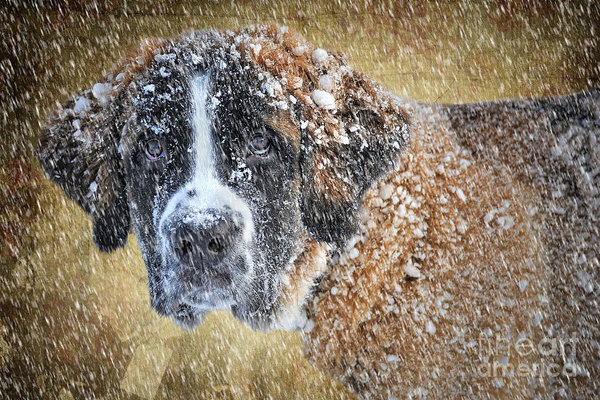
In the monks’ mind, the problem was that short hair was responsible for the deaths of their dogs during severe winters.
Seduced by the thought of building a better mousetrap, the Augustine Monks of Bernard de Menthon thought that breeding their Saint Bernards to a longer haired breed would better protect their dogs against bitter cold. Reasoning that Newfoundlands seemed like a good fit for their Saints, monks at the Saint Bernard hospice did some experimental breedings with Newfoundlands at the beginning in 1830. The results? Not so good.
Ice formed on the long hair of dogs from these breedings when they were out in high snow for any length of time, and the weight of accumulated ice and snow rendered the dogs unable to move to the point of incapacity. The monks ultimately returned to the exclusive use of shorthaired dogs for mountain work and gave away all their longhaired pups. Swiss recipients of the puppies bred them with their own dogs that, not surprisingly, resulting in longhaired and shorthaired puppies. Selective breeding done by the most dedicated Swiss fanciers resulted in the return to the original hospice type dog with only the length of hair differentiating the shorthaired and longhaired varieties.
As famous as the dogs of the St. Bernard hospice were, they didn’t have a breed name at the time. Well traveled English tourists called them Alpine Mastiffs, Hospice Dogs, Holy Dogs, and Saint Bernard Mastiffs. Others called them Monastery Dogs, Swiss Alpine Dogs, or just Mountain Dogs, but most Swiss called the dogs, “Barry Dogs” for the most famous of them all, “Barry der Menschenretter” who was said to have rescued over forty travelers in his lifetime. It seems that consensus was reached in 1880 to call hospice dogs, “Saint Bernards.”
Saint Bernard photograph by Stephen Smith is available for purchase here.

The monks interbred the Saints with Newfs because their lines were dying out due to what was thought to be distemper, not because they were trying to build a better Saint.
“The years 1816 to 1818 were seasons of uncommonly severe weather at the Hospice, and, as a result, many of the leading Hospice strains perished. It was easy at that time, however, to get good animals of like breeding from the lower valleys, and within a few years, the dog situation at the Hospice was again satisfactory. Confronted by a similar situation in 1830, coupled with the fact that their breed was considerably weakened by inbreeding and disease, the Monks resorted to an outcross to give added size and new vigor to their dogs. The Newfoundland, which at that time was larger than the Saint Bernard and shared strong rescuing instincts, was the breed decided upon to give the new blood. Results of this cross showed all of the desired objectives and, at the same time, did not destroy the Saint Bernard type and characteristics. Due to this crossing, however, the first longhaired Saint Bernards appeared – prior to 1830 all the Saint Bernards were shorthaired dogs.”
“At first it was believed that the longhaired variety might have an advantage in the snow and icy conditions existing at the Hospice. Unfortunately, ice clung to the coat and made the longhaired dogs unsuited to the tasks of the rescue dogs. After this was determined, the Monks gave the longhaired dogs as gifts to friends and benefactors in the valley area, and only shorthaired dogs were kept at the Hospice”.
“The English, who as early as 1810, imported some of the Hospice dogs to replenish their Mastiff blood, referred to the breed for a number of years as “Sacred Dogs”. In Germany, around 1828, the name of “Alpendog” was proposed. In 1833, a writer, Daniel Wilson, first spoke of the so-called Saint Bernard dog, but it was not unitl 1865 that his name definitely appeared, and only since 1880 has it been recognized as the official designation for the breed”.
“During the last half of the 1800s, breeding of both of the longhaired and shorthaired Saint Bernards continued in the valleys of Switzerland, and eventually the breed spread across Germany and other continental European countries and England.”
An excellent comment, Dawn. Thanks for the expanded insight into the history of this wonderful breed!